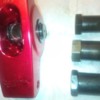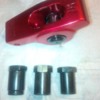Had some valve train noise... I noticed that some pushrods were very loose, but since I hadn't a tick tick, I thought it must be lifters collapsing when engine is not turning. But when I turned the lock nut slightly, the rocker banged down, and now the pushrod was not loose any more. My valve train was binding! How could it? The only thing I had changed during winter were the lock nuts. A-ha! So I took one off, and yes it was deeply scratched, so was the rocker. But why, I got the ones Comp Cam recommends? Here's why. The original locks were .600 OD except the lower 2mm which were .550. The new I got (correct according to Comp Cams catalog) were .600 all the way up and down. And that's too wide for my rockers. Couldn't understand, I have pretty standard Cleveland alu heads and the 1.73 red Comp Cams rockers, I think a lot of us have, right? I called Comp Cams, and while I could hear that they in no way wanted to admit to a problem, they said that the lock nut with only .550 at the bottom was discontinued, and that they didn't have anything smaller than .600. So no help there. I told him that Crane has them in .550 all the way, he said, so use them. So I ordered a set, and put them on tonight. No more binding. Isn't that wild? These red rockers are used by so many people, and they produce locks that don't fit? Am I missing something?
See attached picture. Grind marks visible on rocker both top and bottom. Lock nuts from below:
-Original with .550 bottom 2mm
-New for this winter .600 all the way, grind marks at bottom
-Just bought, .550 all the way
---
So now all should be fine, no binding, no unpleasant engine noises. But oh no, now it gets complicated. First a little history. Ever since I got this Pantera with its 600HP 408 MME engine, I've had a challenging idle, with max 10-15 vacuum if all was adjusted perfectly. I thought, wild cam, that's just the way it is, right? But this spring, I've had a much better idle, above 20, idling like a daily driver. I never understood why, the only thing I could think of was that I had had the intake off and on, maybe I had fixed a vacuum leak, but I've had that intake on and off several times, and this is the first time I've had this perfect idle. Couldn't explain it, and still can't. Here comes the problem. Since my valve train doesn't bind anymore, the idle is back to around only 10. How is that possible? How can one set of locks produce a perfect idle (and bind) and another set produce a lousy idle?
I have a theory. Since the locks I put on this winter were binding, when adjusting the rocker lock height, it must have pushed the rocker down "too early", and when the engine then got started the valve spring force etc quickly ground off some of the rockers and locks and allowed the rocker to move up slightly, just like a very loose setting. In theory it could work. To prove my theory and to get back to a 20+ idle, I therefore tried loosening the rocker lock nuts in 1/4 turn increments. Idle got a bit better, but never near the 20+, and then when I continued, they started to tick, so too loose I guess.
---
Q1: Anybody else had binding problems with standard Comp Cams valve train parts?
Q2: Any ideas why I had perfect idle with binding lock nuts? And how I get back to perfect 20+ idle?
Q3: How should I adjust these rocker lock nuts? Here's how I've always done it: TDC, cyl 1, tighten until pushrod starts to bind, +1/2 turn, tighten counter hex bolt, turn lock nut and hex bolt at the same time to tighten approx. 1/16, then turn engine 1/4, next cylinder, do it 8 times.
That has worked for me for years, but, I must admit, produced the less than perfect idle on my Pantera. Is there a better way? Tonight I also tried the Chevy SB way, covers off, idle, turn loose until tick tick, tighten 1/2 turn. Didn't give me a better idle.
I'm confused. And I want my perfect idle back! Or I'm buying a Porsche!
Attachments
Original Post



